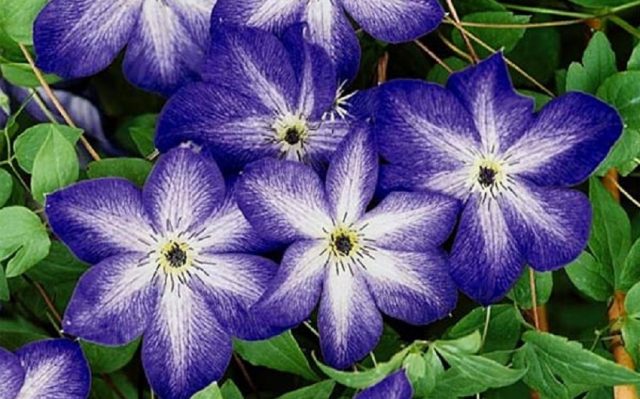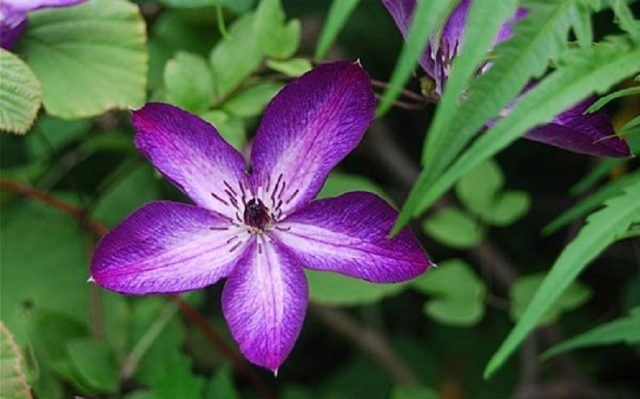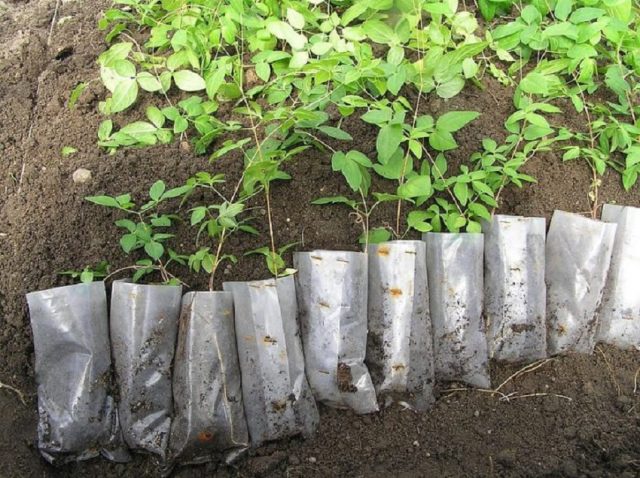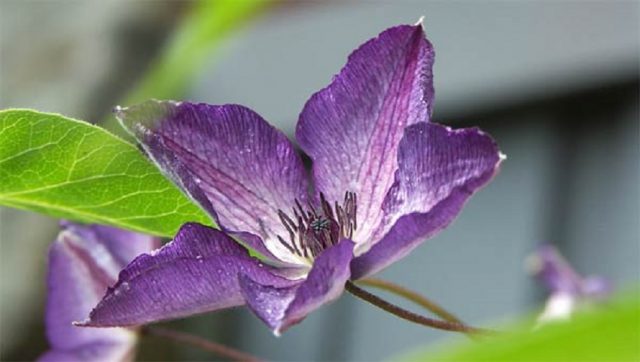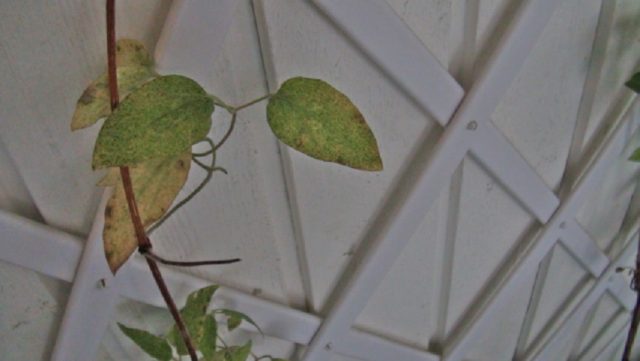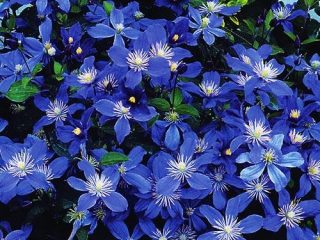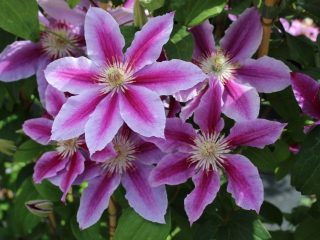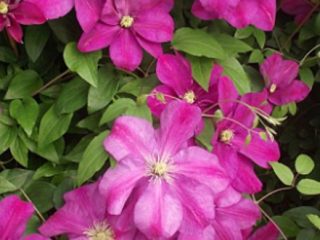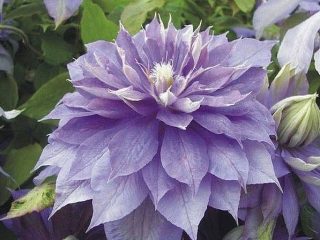Content
Among varietal vines, the most attention of gardeners is attracted by species with an original structure or color of flowers. Clematis Venosa Violacea not only meets these parameters, but also belongs to undemanding healthy varieties. This representative of the buttercup family serves not only for vertical gardening, but also feels great as a ground cover plant.
Description of clematis Venosa Violacea
A beautiful variety was created by French breeders in 1883. It is not known exactly which varieties the Lemoine & Son company chose, but according to some assumptions, the purple clematis (Clematis vitalba) and flowering (Clematis florida) became the parent species. Therefore, the flowers turned out to be very beautiful, interesting in their combination of a white background and purple veins. The originator of the variety is Lemoineet Fils, France. In the photo, Clematis Venosa Violacea:
This variety belongs to the Viticella clematis group, in which Clematis viticella or purple is used for breeding. Venosa Violacea is a weaving vine that can easily be held on vertical natural or artificial supports. Therefore, gardeners plant clematis not only near arches or arbors, but also near shrubs or solitary trees. The plant decorates them beautifully. In addition, it is often grown on balconies or terraces in large containers. Gives an excellent combination with plants with light foliage.
The length of the liana reaches 2-4 m. The length of internodes on the shoots is from 12 to 20 cm. The leaves are pinnate, stick well to the petioles.
Flowers are single bicolor - purple veins contrast against a white background. Petals are simple, in one flower there are 4-6 pieces, the shape of each one resembles an ellipse with a pointed tip. The dark purple anthers are held together by creamy green strings. The diameter of one flower varies from 6 cm to 14 cm.
Has several names - "Violet Stargazer", viticella "Venosa Violacea", "Violet Star Gazer" (US), viticella "Violacea".
Clematis trimming group Venosa Violacea
Pomegranates are divided into pruning groups. Venosa Violacea belongs to the easiest group 3 for gardeners during the period of clematis cultivation. Such varieties bloom longer (up to 3 months) and later than others. After all, bud ovaries occur on the shoots of the current year, so the flowering is postponed. This characteristic affects the order in which clematis is trimmed. For group 3, you need to completely cut out all the shoots, leaving hemp 1-2 buds high (about 15 cm). Varieties of the 3rd pruning group not only grow quickly, but also overgrow very quickly. If you neglect the rules of pruning, you can get a non-decorative matted bush with a lot of shoots. Flowering in this case is significantly reduced. The easiest way to prune Venosa Violacea clematis is in the fall to help prepare for winter and shelter the plant.
Planting and caring for clematis Venosa Violacea
Both measures should be performed in accordance with the description of the clematis variety Venosa Violacea. It is not a new product, so each item has been tested by gardeners in practice and experience.
Planting can be done in spring or fall.
The variety will bloom well and develop only in a suitable place for it. Venosa Violacea loves the sun, the absence of wind gusts and moisture stagnation. Liana will like the place on the southern, southeastern or southwestern side of the site.
If the groundwater is high enough, then you should form a mound for planting clematis or pick it up in the natural landscape.
Autumn planting should only be allowed in warm areas. Where the climate is cool, clematis should only be planted in the spring.
The landing algorithm is identical, the only difference is at the last stage:
- Prepare a cube-shaped pit with sides of 60 cm.
- The first layer is drainage from verticulite, crushed stone or small stone.
- The next layer is prepared from a mixture of fertile soil, humus, sand, sol and superphosphate. Permissible acidity - from slightly alkaline to slightly acidic.
- The sapling is placed on the soil, covered up, lightly tamped.
- It is permissible to leave the root collar at ground level or deepen no more than 5 cm.
- Water immediately, mulch the clematis and shade for a few days.
When planting in autumn, the plant is immediately covered. The distance between two Venosa Violacea vines must be at least 70 cm.
Variety care depends on the period of the year.
In spring, clematis is watered abundantly at least 1 time per week. Conditions that must be met - water should not get on the leaves, the ground remains moist without drying out. As soon as the first shoots appear, the first feeding is applied with a complex mineral composition. The dose is calculated according to the instructions, as well as the time of the repeated procedure. It is important not to forget to mulch the root zone with a layer of 3-5 cm. Water the clematis with milk of lime at the end of spring, but at will.
In summer, planting of clematis from pots is allowed. The best time is August. Such seedlings are planted with a depth of 7 cm below ground level. Continue to regularly water and feed clematis.
Preparing for winter
Clematis varieties of the third pruning group tolerate winter well. Venosa Violacea winters well at -34 ° C, so in the southern regions, gardeners do not cover plants. If you want to play it safe, then after pruning, you can pour dry peat (bucket) onto the center of tillering and leave it until spring. Clematis is cut in October to a height of 20-30 cm. Peat and spruce branches are used for shelter. In the spring, the shelter must be removed, but gradually. This will save the vine from sunburn.
Reproduction
The most popular and affordable breeding methods for the Venosa Violacea variety are vegetative:
- dividing the bush;
- rooting of cuttings;
- grafting.
Division is best done in autumn, in September. After flowering, clematis will tolerate the reproduction operation well. Cuttings are chosen green, it is important not to take the tip of the shoot, propagation with cuttings is a favorite method of novice gardeners. It is very easy to implement and gives almost 100% results. At the same time, all the characteristics of the variety are completely preserved. A little more about grafting:
Diseases and pests
Clematis of the Venosa Violacea variety is susceptible to fungal diseases. Of these, the most to be feared is fusarium, powdery mildew, brown spot, wilting. High humidity is the cause of the spread of problems. In order not to fight the disease, gardeners need to pay enough attention to prevention. Clematis can be treated with special preparations - fungicides, for example, "Fundazol". Treatments and root watering with a solution of this agent are also used by gardeners for preventive purposes. Insecticides are used against pests. The most common species are spider mites, nematodes, snails, or slugs. For prevention against such pests, folk compositions are good.
Conclusion
Clematis Venosa Violacea is a very comfortable variety for gardeners. By following the minimum list of agrotechnical measures, you can achieve amazing decorativeness of the plant. Low demand for growing conditions, lush flowering and disease resistance are the main advantages of clematis.
